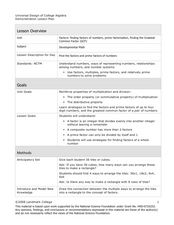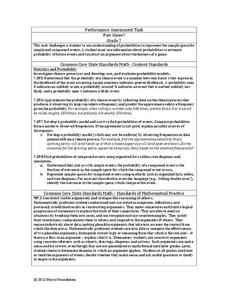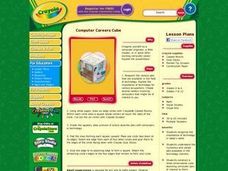Utah Education Network (UEN)
Insides and Outsides
Give small groups handfuls of unit cubes and then dare them to build as many rectangular prisms as possible using only 12 cubes. This engaging activity serves as an introduction to the volume of solid figures. In addition to volume,...
Curated OER
Find the Factors and Prime Factors
Show the class how to find the factors of numbers. They use a variety of strategies, including unifix cubes, to find the factors of a whole number. This resource includes clear procedure to follow. Included are an anticipatory set,...
Pala Software
MathBoard
Do you want to practice arithmetic skills from simple addition facts, to cubes and square roots, to solving one-step equations? Here is a great app for practicing and learning everything from arithmetic practice using integers to solving...
Curated OER
Groundwater Basics
Groundwater is an essential natural resource, not to mention a fascinating topic to study. Here is a series of twelve amazing lessons on the water source and how we use it in our daily lives. Concepts require higher math and physics...
Worksheet Fun
Convert between Percents, Fractions and Decimals #1
Pre algebraic learners will be able to master conversion of fractions, decimals, and percents in no time when they use the illustrations on this resource.
Curated OER
Volume of Solid Figures
Learners calculate volume using the correct formula and the correct unit. They explore different prisms, spheres, cubes, and cones as they calculate volume and relate it to depths in oceans.
Curated OER
Measuring Up
Students examine and discuss a variety of ways to measure length, capacity, and weight. They estimate and measure a pencil's length using Unifix cubes, estimate and fill a measuring cup with Unifix cubes, and weigh a calculator in a...
Virginia Department of Education
Volume of a Rectangular Prism
Fill the minds of your young mathematicians. A hands-on activity has learners fill in a rectangular prism with unit cubes to determine its volume. the exercise provides a great hands-on way for learners to connect the activity...
EngageNY
Understanding Variability When Estimating a Population Proportion
Estimate the proportion in a population using sampling. The 20th installment in a series of 25 introduces how to determine proportions of categorical data within a population. Groups take random samples from a bag of cubes to determine...
Houghton Mifflin Harcourt
Explore Volume - Practice 17.6
When youngsters are first gaining experience with the volume of solid figures, this is a well-suited worksheet. Nine figures, all made of unit cubes, are drawn for your class to estimate volumes with. Two simple test preparation...
Noyce Foundation
Building Blocks
Building blocks have more uses than simply entertaining children. Young mathematicians calculate the volume of a given cube, and then calculate the volume and surface area of a prism formed from multiple cubes.
Virginia Department of Education
Attributes of a Rectangular Prism
A change is coming. Pupils use unit cubes to investigate how changes in the length, width, and/or height affects volume and surface area. They extend the results to write and test predictions on the effect of changing multiple sides on...
Curated OER
Primary Counting Skills
Class members drill and practice counting skills from 1 to 20. They count along with a puppet and when the puppet makes a mistake, they correct it. In pairs, they connect cubes to make a train and count the number used. On the last of...
Noyce Foundation
Fair Game?
The game should be fair at all costs. The mini-assessment revolves around the ability to use probabilities to determine whether a game is fair. Individuals determine compound events to calculate simple probabilities and make...
McGraw Hill
Adding and Subtracting Radicals
Help remove some of the confusion surrounding the addition and subtraction of radical numbers with this set skills practice problems. Taken straight from the pages of a math text book, this resource provides learners with...
Curated OER
Crazy for Cubes: Art and Science
Learners discuss Sol LeWitt and conceptual art, then analyze the differences in expressing a concept through model-based inquiry and aesthetic art criticism. They develop a geometric, scientific, or mathematical concept, then create an...
Curated OER
Cube Net
In this math worksheet, students cut, fold and tape the math net to construct a model of a cube. Students learn to recognize the solid geometric shape of the cube.
Curated OER
Unit Cubes
In this unit cube worksheet, students solve 3 different problems that contain various parts to each of them. First, they write as many 3-digit numbers as they can given the numbers 2, 3, 5, and 7. Then, students count how many unit cubes...
Curated OER
Patterns
Fifth graders investigate the use of patterns in a data set. The set is disolayed visually using cubes. This helps struggling students to see the quantity in order to make comparisons more effectively.
Curated OER
Name the 3 Dimensional Shapes of the Objects
Here are six solid figures for learners to identify. The names are listed along the left side and the shapes pictured on the right. Each shape is shown as a familiar object instead of just a drawing. Figures include a cylinder,...
Curated OER
Recognize and Draw Shapes
What type of shape is this? Learners practice identifying shape attributes as they name a parallelogram and an oval and count the sides of a cube and a triangle. There are multiple-choice answers for the shape-name questions, so...
Curated OER
Finding Angles, Volume, Area, and Perimeter
Elementary schoolers complete word problems dealing with the different kinds of measurements of different shapes. They solve 10 problems including perimeter, angles, volume, and more.
Curated OER
Computer Careers Cube
Students use the internet to research the types of careers in technology. Using construction paper, they draw themselves in one or two of the careers they found interesting. To end the lesson, they share their drawings with the class and...
Primary Resources
Volume (Lesson 1)
Add to your teaching tools an interactive presentation in that it's meant to be used in tandem with manipulative cubes. Each slide asks pupils to create a shape that uses a certain number of unit cubes. They are encouraged to make as...

























